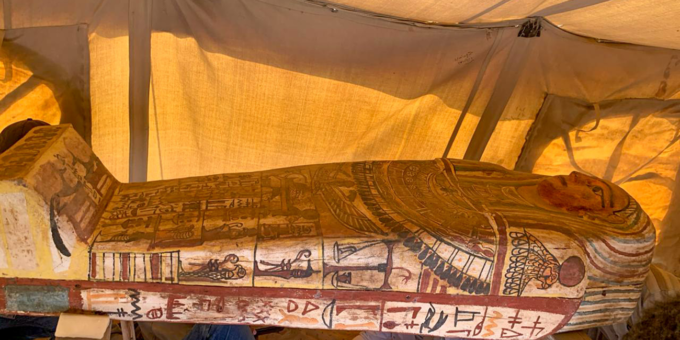
CAIRO: Archaeologists in Egypt have discovered 27 coffins that were buried more than 2,500 years ago in a pharaonic cemetery.
The sarcophagi were found at the Saqqara site in the governorate of Giza, south of the Egyptian capital, Cairo.
Egyptian antiquities officials believe the discovery to be the largest of its kind in the region. Saqqara was an active burial ground for more than 3,000 years and is a UNESCO World Heritage Site.
Initial studies indicate that the coffins and shrouds inside have remained tightly sealed since burial, according to the Egyptian Ministry of Antiquities.
The discovery was part of an Egyptian dig in the Saqqara area which unearthed an 11-meter-deep well containing colorfully painted wooden coffins stacked on top of each other along with other smaller artefacts.
Khaled Al-Anani, the Egyptian minister of antiquities, postponed announcing the discovery until he could visit the site himself, where he thanked teams for working in difficult conditions.
Ahmed Abdel Aziz, a professor of pharaonic archeology at a private university, said: “This new discovery is not the first in the Saqqara archaeological area. Archaeological discoveries have increased over the past years which draw attention to this region.
“This prompted many archaeological missions from many countries to work in this region, trying to probe the depths of this region and the treasures hidden inside it.”
Al-Anani said the increase in archaeological discoveries and the number of projects recently implemented by the Ministry of Antiquities were down to political will and exceptional support from the Egyptian government.
He pointed out the importance of resuming the work of 300 archaeological missions from 25 countries after a hiatus of a number of years, including some working in Egypt for the first time such as the joint Egyptian Chinese archaeological mission.
There were about 50 Egyptian missions working at sites in governorates throughout the country and Al-Anani praised their efforts in helping to unearth more evidence of ancient Egyptian civilization.
Mustafa Waziri, secretary-general of the Supreme Council of Egyptian Antiquities, said that Saqqara was one of the most promising historical areas when it came to archaeological discoveries, adding that he planned to continue working in the area with his mission members to uncover more secrets and treasures of the past.
He noted that new finds during the current excavation season would have a positive impact on tourism in Egypt at locations such as Giza, Saqqara, Luxor, and Aswan.
Mohamed Abdel Hamid, vice president of the Egyptian Association for Tourism and Archaeological Development, said that the discovery was a testament to the architectural development of the area that could be seen in King Djoser’s collection. The pharaoh was found in a step pyramid which was the first tomb in Egypt to be built using stones.













